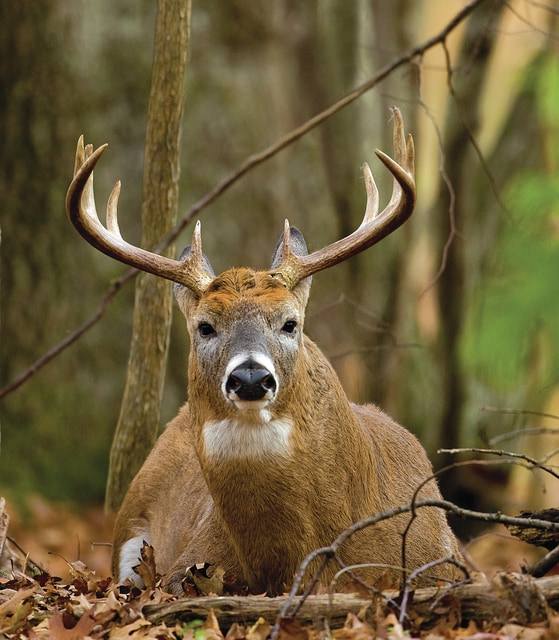GREENE COUNTY — Greene County led the way in the amount of deer strikes that occurred within the Miami Valley last year, with 137 taking place from October to December. Miami County, found in the northwest direction, followed as the second highest amount with 107 accidents involving the hoofed animal.
Lt. Douglas Eck, post commander at the Xenia post for the State Highway Patrol said deer strikes are common this time of year in Ohio, especially within rural areas. This can be credited to crop removal and the animal’s natural mating season taking place this time of year, both causing deer to be on the move.
“People need to always pay attention to what’s in front of them or what’s to their left or right to look for crossing animals,” Eck said.
He counted approximelty 40 deer strikes within Greene County since Oct. 1 this year on roadways such as U.S. Routes 35, 68, State Routes 42, 72, 235, 725, 380, Interstate 675, Trebein Road, South Charleston Road, Col. Glen Highway, Ludlow Road, Dayton-Yellow Springs Road, Hyde Road, North Enon Road, Ludlow Road, Waynesville Road, Clifton Road, Hussey Road, Factory Road, Upper Bellbrook Road, Beaver Valley Road, Selma-Jamestown Road and Wilberforce-Clifton Road.
Some of these roadways, such as U.S. Route 35, have already included multiple strikes. However, Eck credits this to the higher volume of traffic this path carries.
“October, November and December are the months we see the greatest number of deer-related crashes, especially November because it’s the height of mating season,” AAA Driving School Instructor Pat Brown said. “With the recent time change and as the days get shorter, drivers are more likely to be on the road at dawn and dusk when the animals are most active.”
If drivers encounter a deer on or near a roadway, Eck said it is essential that they don’t swerve, as this may cause the driver to lose control of the vehicle and put them at risk for crashing into something more solid, such as a building or another vehicle. He also recommended using bright lights, as this helps illuminate them, in addition to keeping speeds at a reasonable rate.
“It is essential that drivers stay focused and alert especially when driving in densely populated deer areas,” Brown said. “The highest risk times are from sunset to midnight, followed by shortly before and after sunrise”.
While some may believe that speeding up in an attempt to roll the deer over the vehicle may be a reasonable option, Eck said doing so poses a bigger risk.
“The higher the velocity, the greater the chance the deer will penetrate the windshield,” he said. “If you’re moving slower, you’re less likely to lose control. Slower speed crashes are the best option [if you’re in a situation where it is inevitable.]”
Each year nationally, more than one million crashes are caused by deer and worse yet, animal collisions result in about 200 human fatalities per year.
According to the Ohio Department of Public Safety, there were 19,705 deer strikes in Ohio last year and 48 percent of the crashes occurred during the months of October, November and December. Last year there were 1,354 deer related crashes reported in the Miami Valley, with 644 of the crashes happened during the months of October, November and December.
Miami Valley Area Vehicle/Deer Crashes By County; October – December 2014:
– Greene County – 137
– Miami County – 107
– Clark County – 96
– Darke County – 95
– Montgomery county – 79
– Preble County – 66
– Champaign County – 64
AAA Driving School offers these tips to reduce the likelihood of being involved in a vehicle-deer crash:
· Scan the road and shoulders ahead of you. Looking ahead helps provide enough reaction time if a deer is spotted. Also, remember deer often move in groups, so when there is one deer, there are usually more in the area.
· Use high beam headlights if there’s no oncoming traffic. Deer may be spotted sooner when using high beams — allowing time to slow down, move over or beep to scare the deer away.
· Slow down around curves. Animals are harder to see in advance when going around curves.
· If a collision is unavoidable, apply the brakes firmly and remain in your lane. Swerving away from animals can confuse them so they don’t know which way to run. It can also put you in the path of oncoming vehicles or cause you to lose control of the vehicle and crash.
· One long blast. A long blast on your horn may frighten large animals, like deer, away from your vehicle.
· Drivers should always wear a seat belt and remain awake, alert, and sober.
· Be extra cautious at dawn and dusk. Drivers should exercise extra caution early in the morning and at dusk because deer tend to be more active at these times.
What to do if a deer strike occurs:
If you are unable to avoid a collision and hit a deer, do not get out the car and attempt to touch the deer, it could harm you.
· Turn on your hazards to alert other motorists and call 911.
· If possible, remove your car from the roadway, but only if the deer has left. Otherwise, keep your lights on to keep other traffic from striking you or the deer.
“Find a safe place to pull over and call 911,” Eck said. “Either the highway patrol, local police or sheriff will come and take a report. Turn your four-ways on so other motorists can have a warning, and stay in the car. Don’t wave people down to warn them because you might get hit yourself. They’ll come out and make a report, make sure your vehicle is drive-able and if not, call a tow truck for you.”






